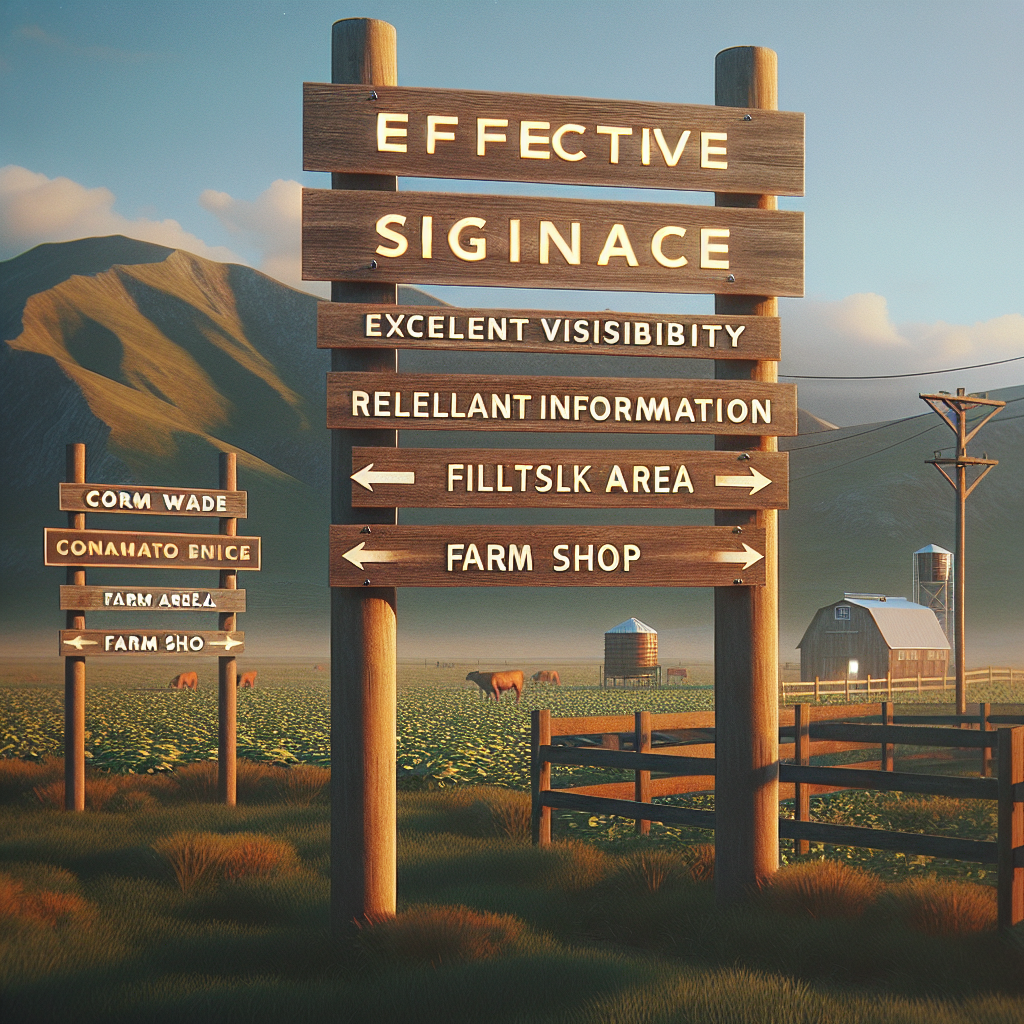Introduction to Farm Signage
Ever wondered why farm signage matters? Sure, they point in the right direction or offer a fun fact or two. But there’s more to it than you might think. Effective signage can significantly impact the success of an agricultural business. That’s where this guide comes in.
From enlightening us on the importance of clear messaging, typography, and color schemes to guiding us through the roles of various types of signages, this comprehensive guide covers it all. We’ll explain the importance of planning signage to be weather-resistant, compliant, and representative of brand elements. We’ll also touch upon the need for regular maintenance.
Ever questioned why your signs ought to include branding elements or follow local regulations? Curious about the benefits of having different types of signs, for example, directional signs and informational signs? All these and more are answered in this article. Remember, truth will only illuminate if it shines in all directions – and so should your farm signage!
Effective Farm Signage Tips
Clear and Concise Messaging
Effective farm signage relies on clarity. Ensure your message is straightforward and easily understood. Avoid jargon.
- Use simple language.
- Short sentences or phrases work best.
- Highlight the most important information.
Readable Fonts and Sizes
Typography plays an essential role in readability. Choose fonts and sizes wisely for maximum legibility.
- Opt for sans-serif fonts like Arial or Helvetica.
- Use large font sizes, ideally above 30pt.
- Keep sufficient spacing between letters and words.
Colors and Contrast
The right color scheme ensures visibility, even from a distance or in low light.
- High contrast between text and background is essential. For example, black text on a white background.
- Avoid overly bright or neon colors as they can be hard to read.
- Use a consistent color scheme across all signs.
Directional and Informational Signs
Different signs serve different purposes. Determine the type needed and design accordingly.
- Directional signs should have arrows and clear destinations.
- Informational signs can include details about crops, animals, or farm history.
- Safety notices, like “Danger” or “No Entry”, should be immediately visible and clear.
Weather-Resistant Materials
Ensure your signs withstand the elements to stay effective over time.
- Use weatherproof materials like metal or treated wood.
- Laminated paper signs for temporary notices can weather minor exposure.
- Consider UV-resistant coatings to prevent sun damage.
Placement and Visibility
Where you place your signs affects how well they communicate.
- Install signs at eye level for easy reading.
- Place signs at decision points, such as forks in the road or entry gates.
- Ensure there’s enough lighting for signs to be visible at dawn, dusk, or night.
Compliance with Local Regulations
Ensure your signage adheres to local laws and regulations for outdoor signs.
- Check local zoning laws and sign codes.
- Acquire necessary permits if required.
- Follow guidelines on sign size, height, and placement.
Include Branding Elements
Farm signs can also reinforce your brand identity.
- Incorporate your logo and farm colors into the design.
- Use consistent fonts and colors across all signage for a cohesive look.
- Add your farm name or website for more exposure.
Regular Maintenance
Maintaining your signs is essential for long-term effectiveness.
- Inspect signs regularly for wear and tear.
- Clean signs to remove dirt, mold, or bird droppings.
- Replace damaged or outdated signs promptly.
For further tips on effective signage, check out this helpful resource on FarmProgress.com.
Why Effective Farm Signage is Essential for Agricultural Business
Enhances Brand Recognition
Having a cohesive look across all your signage is a potent method to enhance your farm’s brand recognition. It forms an instant connection with the audience and makes your farm memorable.
- Consistent use of logos and brand colors can raise brand awareness.
- A tagline or slogan on signs can reinforce the brand image.
- It differentiates your farm from others, providing a competitive edge.
Improves Safety and Liability
Effective signage not only provides essential information but also enhances safety and limits liability.
- Proper safety signs can prevent accidents by informing visitors about potential hazards.
- Warning signs can lessen potential legal liability in case of accidents.
- Providing animal safety signs can help protect livestock.
Boosts Visitor Experience
Signage plays an essential role in shaping the visitor experience in your agricultural business.
- Clear directional signs can improve visitor movement & reduce confusion.
- Informational signs can educate visitors about farming processes and history.
- Good signage helps create an organized, visitor-friendly environment.
Serves Marketing Purposes
Effective signage can act as a constant marketing tool attracting and informing potential customers.
- Signage can advertise your products, services, or events at the farm.
- Creative signs can capture attention and trigger local word-of-mouth marketing.
- Call-to-action signs can direct visitors towards specific activities like farm tours or product purchases.
Aids in Conservation Efforts
Signage can also play a part in your farm’s conservation efforts, educating visitors and employees alike.
- Signs can inform visitors about eco-friendly farming practices you undertake.
- Reminders for litter disposal and recycling can contribute to a cleaner environment.
- Signs highlighting restricted areas can protect wildlife habitats or conservation projects on the farm.
For more detailed information, the National Ag Safety Database provides thorough guidelines for effective farm signage NASDonline.org.
Examples of Effective Farm Signage
Wayfinding Signs
Wayfinding signs are essential for guiding visitors around your farm smoothly.
- Entrance Signs: Clearly marked entrances help direct traffic efficiently.
- Parking Area Signs: Indicate where visitors can park to avoid confusion and congestion.
- Trail Markers: If your farm includes walking paths or trails, ensure they are well-marked.
Educational Signs
Educational signs can inform visitors about various aspects of your farm.
- Crop Identification Signs: Indicate what type of crops are grown and offer brief information about them.
Promotional Signs
These signs can help market your products and services directly on-site.
- Product Listings: Display pricing and product availability, such as fresh produce or dairy products.
- Event Announcements: Advertise upcoming events like farm tours, seasonal festivals, or workshops.
- Special Offers: Highlight any discounts or special promotions available to visitors.
Visitor Etiquette Signs
Ensure your visitors know how to behave to maintain a safe and respectful environment.
- Pet Policies: Specify whether pets are allowed and any restrictions they must follow.
- Restricted Areas: Clearly mark areas that visitors are not allowed to enter to ensure safety.
- Trash and Recycling: Direct visitors to disposal and recycling locations to keep the farm clean.
Operational Signs
Support the daily operations of your farm with clear operational signage.
- Staff Only Areas: Clearly mark areas restricted to farm staff to ensure safety and privacy.
- Equipment Storage: Indicate where different types of equipment should be stored for organization.
- Procedure Notices: Post signs outlining daily procedures or safety protocols for employees.
Seasonal Signs
Adapt your signage according to the season to keep it relevant and engaging.
- Seasonal Crops: Highlight seasonal produce with signs to attract customer interest.
- Holiday Decorations: Add festive elements to your signs during holidays to create a welcoming atmosphere.
- Weather-Related Notices: Include signs warning of specific seasonal hazards, like icy pathways or extreme heat.
For those looking for more examples and best practices, FarmProgress.com offers comprehensive resources for farm management and operations.
How to Design the Most Effective Farm Signage
Embedding Technology
Incorporating technology into your signage can offer interactive and dynamic experiences for visitors.
- QR Codes: Add QR codes to signs that link to your website, educational videos, or event details.
- Digital Displays: Use electronic boards for up-to-date information and easy updates.
- AR Experiences: Implement Augmented Reality (AR) for a richer visitor experience.
User-Friendly Design Principles
Effective design goes beyond just looks; it ensures functionality and usability.
- Universal Symbols: Use universally recognized icons for directions or warnings to break any language barriers.
- Hierarchy of Information: Structure content with the most critical information first to ensure quick comprehension.
- Visual Cues: Use arrows, borders, and other graphic elements to guide eyes to essential info.
Customizing for Audience
Tailoring your signage to your specific audience can significantly enhance its effectiveness.
- Multilingual Signs: If your farm attracts diverse visitors, consider signs in multiple languages.
- Family-Friendly: Use more engaging, colorful designs if your farm caters to families and children.
- Agritourism Signs: For farms focused on tourism, include local attractions or tours information.
Improving Engagement
Make your signs more engaging to capture attention and communicate effectively.
- Storytelling: Use signs to share stories about your farm’s history or your farming practices.
- Interactive Elements: Install hands-on elements like small sample crops or feeding areas near educational signs.
- Fun Facts: Incorporate interesting trivia or fun facts to make signs more enjoyable for visitors.
Involving the Community
Community involvement can make signage more relevant and supportive of local engagement.
- Community Art: Collaborate with local artists for unique and culturally resonant designs.
For those looking for more examples and best practices, FarmProgress.com offers comprehensive resources for farm management and operations.
Conclusion: Effective Farm Signage
Providing effective farm signage is about more than just marking paths or conveying messages. They have become a vital part of the agricultural business, aiding brand recognition, safety measures, visitor experience, marketing efforts, and conservation work. A well-strategized signage system involves a wide spectrum – wayfinding and promotional signs, informational and operational notices, user etiquette indications, and adaptable seasonal signage.
By employing clear messaging, readable fonts, high contrast colors, distinctive directional indications, and weather-resistant materials, farm signage ensures fluid navigation and effective communication. Additionally, its importance also lies in its adherence to local regulations while reflecting the brand’s identity. The article also encourages regular maintenance to ensure long-term effectiveness of these signs.
The article highlights the apt integration of technology that adds an interactive dynamic and ways to enhance user-friendly design principles. The importance of customizing signage to cater to specific audiences, building more engaging elements, and harnessing community involvement elevates the signage experience, marking the essential role they play in a farm’s effective functioning.
Frequently Asked Questions – FAQs
What’s the importance of clear messaging in farm signage?
Clear messaging ensures that the information on the sign is easily understood, avoiding confusion or misinterpretation. It typically involves using simple language and highlighting the most important information.
Why is font choice important in sign readability?
Font choice can dramatically affect a sign’s readability. Sans-serif fonts like Arial or Helvetica are typically easier to read, especially in larger sizes and with adequate spacing between words and letters.
How does color and contrast affect sign visibility?
High contrast between text and background can make signs much more visible, even from a distance or in low light. Avoiding overly bright or neon colors that can be hard to read also aids visibility.
How can farm signs enhance brand recognition?
Consistent use of logos, farm colors, and fonts across all signage can enhance a farm’s identity and brand recognition, making it more memorable to visitors and differentiating it from competitors.
How can technology be embedded in farm signage for better experiences?
QR codes, digital displays, and Augmented Reality (AR) experiences on signs can offer interactive and dynamic experiences for visitors, providing in-depth information and real-time updates.






